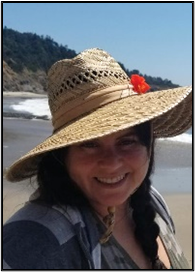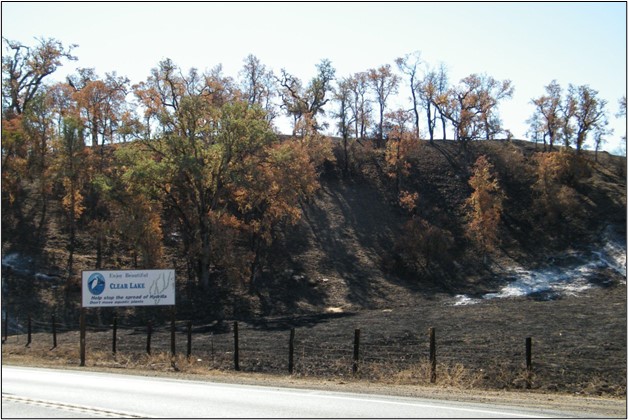How an MSU alum is helping California navigate its water crisis
Angela DePalma-Dow, a recent graduate of MSU with a master’s degree in Fisheries and Wildlife, is doing research on water quality in the face of wildfires and climate change.

Under normal circumstances, feeding a nation and supplying 40 million people with water is challenging enough, but California is currently in one of the longest and most severe droughts in state history.
Not only do people need water, but they also need clean water. In an era of water scarcity, issues surrounding water quality can easily fall behind the focus of water quantity. Nonetheless, the ability of water managers to maintain clean water can become even more important when water supplies are stretched thin.
Angela DePalma-Dow, a recent graduate of MSU with a master’s degree in Fisheries and Wildlife, has helped manage Clear Lake in Lake County, California since early 2018. Located about 120 miles north of San Francisco, Clear Lake is California’s largest naturally formed freshwater lake – Lake Tahoe is larger, but is shared with Nevada.
Clear Lake is primarily used for irrigation, recreation, and tribal cultural practices, but also provides drinking water for 40,000 people, including 60% of the county’s population, the majority of whom are low income and/or members of local tribes such as the Big Valley Band of Pomo Indians, Hebematolel Pomo of Upper Lake, Robinson Rancheria, Scotts Valley Band of Pomo Indians, and Elem Indian Colony.
In collaboration with the California Department of Water Resources and tribal agencies, DePalma-Dow oversees long-term water quality monitoring in Clear Lake, a program that dates back to the late 1960s. The long-term data have shown that Clear Lake has become much more nutrient-rich and productive over time, a process known as eutrophication.
Eutrophication is usually fueled by increased nutrient inputs – primarily phosphorus – from agricultural fertilizers and lawn treatments. Nutrients lead to growth of both algae and cyanobacteria, making the water turn green. When algae and cyanobacteria die and decompose, this commonly results in foul odors, health-threatening toxins, and disruptions to recreation and enjoyment of the lake.
Whereas eutrophication is generally a long-term process, something unexpected happened during the summer of 2018. The Mendocino Complex wildfire, which at the time was the largest in California history, burned 40% of the Clear Lake watershed – the land area that drains into the waterbody. Past research has shown that burned watersheds can significantly increase phosphorus inputs to lakes, potentially worsening eutrophication. Therefore, DePalma-Dow was eager to see what might happen in Clear Lake following the fire.
Over the next three years, however, phosphorus concentrations in Clear Lake remained similar to pre-fire levels. DePalma-Dow said this was somewhat puzzling, so alongside her research team, she turned to the long-term data for answers. Looking back at other years with significant wildfires in the Clear Lake watershed, the results were the same. Phosphorus concentrations were still generally increasing over time, but there were no spikes following wildfires.

“Based on other studies, we expect rain in burned areas to wash large amounts of nutrients into lakes,” said Dr. Ian McCullough, a research scientist at MSU and co-author on the study.
In contrast, the researchers found that nutrient concentrations were already so high in Clear Lake that not even major wildfires were enough to move the needle.
“We actually found that higher phosphorus concentrations over the long term were associated with hot and dry weather, not rain or rain following wildfires,” McCullough added.
In other words, climate change may be a larger threat to Clear Lake water quality than wildfires.
“What could be happening here is release of phosphorus from the lake sediment,” said Dr. Jennie Brentrup, an aquatic scientist at the Cary Institute of Ecosystem Studies and co-author on the study. “Part of the issue is that warmer water holds less oxygen and decomposing algae and cyanobacteria also use up oxygen at the lake bottom. So as the lake heats up and less oxygen is available, more phosphorus can be released from the sediment and mix into the surface waters, further fueling the cycle of eutrophication.”
DePalma-Dow believes that she, along with other lake managers, are going to have to continue to evaluate the situation.
“We really need to keep the long-term monitoring going, particularly for nutrients, because while we have some control over nutrient inputs locally, we don’t for larger climate shifts and changes,” she said. “But we also need to recognize that major wildfires could still pose a threat to other lakes even if we didn’t find that to be the case with Clear Lake. We were fortunate to have the long-term data so we could look at Clear Lake both before and after the fire. That made this investigation really unique and special. It’s really hard to manage water quality in a changing world if we are not sure how much the water quality is changing.”
The published research article can be freely downloaded here: https://doi.org/10.1002/ecs2.4271



 Print
Print Email
Email
